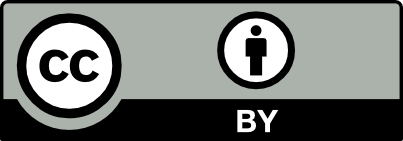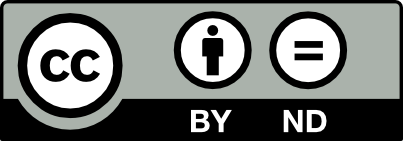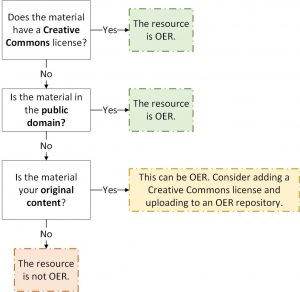1 What is Open Education?
Open education is an attitude, a practice, and a method of teaching that inspires inquiry, equal access to course materials, and sharing lessons and materials with the wider community. At the center of open education is the belief that education is strengthened when shared openly. In addition, the Open Education movement is rooted in the human right to access high-quality education. This movement aims to reduce costs by providing access to openly licensed content. In addition, the movement aims to expand opportunities to participate in creating and sharing education and to expand the existing bodies of knowledge to include more BIPOC perspectives and voices. Open education relies on open educational resources (OER) and open licensing.
Open Educational Resources
Open Educational Resources (OER) are teaching, learning and research materials in any medium that reside in the public domain or have been released under an open license that permits no-cost access, use, adaptation and redistribution by others.[3] Or you could use this less technical definition to describe OER to someone: OER are educational materials that can be freely downloaded, edited, and shared to better serve all students.[4]
This video is an adaptation of ‘What is OER?’ from The Council of Chief State School Officers under CC-BY-4.0. Featuring Barbara Soots, Layla Bonnot, Katie Steen and Nicole Allen
The 5 R’s of Open Educational Resources:
- Reuse: use the work for your own purposes
- Remix: combine multiple resources to make a new work
- Revise: adapt, modify or translate the work
- Retain: keep and download the work forever
- Redistribute: share the work freely with others
How does open licensing work?
By default, all works are automatically granted copyright. Even in the absence of a copyright symbol “©”, the work cannot be assumed to be openly available for use. Registration with the local copyright office is not required to gain copyright protection. Under copyright, no one else can copy, distribute, publicly perform, adapt, or do almost anything else other than simply view or read the work without permission of the copyright holder. Copyright lasts a long time. In the United States copyright lasts 70 years after the death of the copyright holder. The combination of very long terms with automatic protection has created a massive amount of “orphan works” — copyrighted works for which the copyright holder is unknown or impossible to locate.
Open licenses from Creative Commons (CC) provide a way for creators to retain their copyright and get credit for their work, while permitting others to copy and distribute it. The four license elements—BY, SA, NC, and ND—combine to make up six different license options. All of the licenses include the BY condition. In other words, all of the licenses require that the creator be attributed in connection with their work. Beyond that commonality, the licenses vary whether (1) commercial use of the work is permitted; and (2) whether the work can be adapted, and if so, on what terms.
CC Licenses
The six licenses, from least to most restrictive in terms of the freedoms granted reusers, are:
 The Attribution license or “CC BY” allows people to use and adapt the work for any purpose (even commercially) as long as they give credit to the creator.
The Attribution license or “CC BY” allows people to use and adapt the work for any purpose (even commercially) as long as they give credit to the creator. The Attribution-ShareAlike license or “CC-BY-SA” allows people to use and adapt the work for any purpose (even commercially), as long as they give credit to the creator and make any adaptations they share with others available under the same or a compatible license. This is CC’s version of a copyleft license.
The Attribution-ShareAlike license or “CC-BY-SA” allows people to use and adapt the work for any purpose (even commercially), as long as they give credit to the creator and make any adaptations they share with others available under the same or a compatible license. This is CC’s version of a copyleft license. The Attribution-NonCommercial license or “CC-BY-NC”allows people to use the work, or adaptations of the work, for noncommercial purposes only, and only as long as they give credit to the creator.
The Attribution-NonCommercial license or “CC-BY-NC”allows people to use the work, or adaptations of the work, for noncommercial purposes only, and only as long as they give credit to the creator. The Attribution-NonCommercial-ShareAlike license or “CC-BY-NC-SA” allows people to use and adapt the work for noncommercial purposes only, and only as long as they give credit to the creator and make any adaptations they share with others available under the same or a compatible license.
The Attribution-NonCommercial-ShareAlike license or “CC-BY-NC-SA” allows people to use and adapt the work for noncommercial purposes only, and only as long as they give credit to the creator and make any adaptations they share with others available under the same or a compatible license. The Attribution-NoDerivatives license or “CC-BY-ND” allows people to use the unadapted work for any purpose (even commercially), as long as they give credit to the creator. They may also adapt the work for their own personal use but may not share any adaptations publicly.[1]
The Attribution-NoDerivatives license or “CC-BY-ND” allows people to use the unadapted work for any purpose (even commercially), as long as they give credit to the creator. They may also adapt the work for their own personal use but may not share any adaptations publicly.[1] The Attribution-NonCommercial-NoDerivatives license or “CC-BY-NC-ND” is the most restrictive license offered by CC. It allows people to use the unadapted work for noncommercial purposes only, and only as long as they give credit to the creator. They may also adapt the work for their own personal use but may not share any adaptations publicly.
The Attribution-NonCommercial-NoDerivatives license or “CC-BY-NC-ND” is the most restrictive license offered by CC. It allows people to use the unadapted work for noncommercial purposes only, and only as long as they give credit to the creator. They may also adapt the work for their own personal use but may not share any adaptations publicly.Public Domain
In addition to works within the Creative Commons, Open Educational Resources can include any work within the public domain. The public domain consists of works that are not subject to copyright. Works enter the public domain in one of four ways:
- The copyright expires.
- The work was never entitled to copyright protection. This includes ideas, facts, and U.S. government works (because the works are considered public resources according to Section 105 of U.S. Copyright Law).
- The creator dedicated the work to the public domain before copyright has expired (see public domain tools, below).
- The copyright holder failed to comply with formalities or maintain their copyright. Today in most countries, there are no formal requirements to acquire or renew copyright protection over a work. This was not always the case, however, and many works have entered the public domain over the years because a creator failed to adhere to formalities.
In addition to the CC license suite, CC also has two public domain tools represented by the icons below. These public domain tools are not equivalent to licenses:

CC0 enables creators to dedicate their works to the worldwide public domain to the greatest extent possible.

The Public Domain Mark is a label used to mark works known to be free of all copyright restrictions. Unlike CC0, the Public Domain Mark has no legal effect when applied to a work. It serves only as a label to inform the public about the public domain status of a work and is often used by museums, libraries and archives working with very old works.
What can you do with a work that is in the public domain? Similar to a CC-BY 4.0 license, works within the public domain can be freely shared and used, retained, remixed, adapted for any purpose (even commercially). When using works in the public domain, provide an appropriate attribution and original source information. See the Public Domain Guidelines.
Examples of OER
| Title | Notes |
| Nursing Pharmacology by Open RN | Print book $42 |
| Microbiology by OpenStax | Print book $25 |
| Principles of Pharmacology by LibreTexts | |
| Medication Safety in Polypharmacy by World Health Organization | |
| Pride and Prejudice by Jane Austen | Expired copyright; public domain |
| Medicines by Design by U.S. Department of Health & Human Services | Government resource; public domain |
Is my textbook an OER?

This chapter adapts and remixes content from Student Success with Open & Affordable Resources (OER 101) from Vince Mussehl, provided under CC-BY 4.0; content from the Community College Consortium for OER (e.g. What is Open Education), provided under CC-BY 4.0; and copyright information from the Creative Commons Certificate for Educators, Academic Librarians and GLAM from Creative Commons, under CC-BY 4.0

